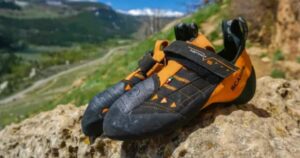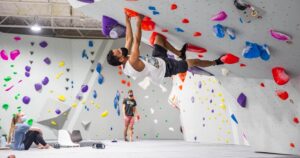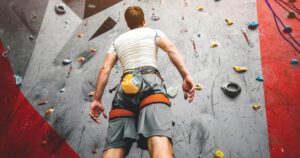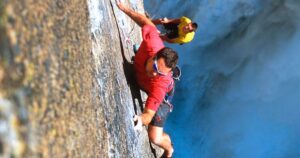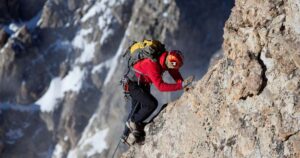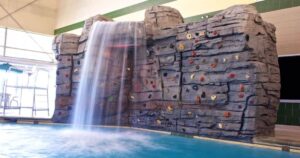Did you know that over 40% of rock climbing injuries occur due to inadequate warm-up? Properly warming up before a climbing session is crucial for both performance and injury prevention. In this article, we will explore the essential components of a rock climbing warm-up routine. From dynamic stretching exercises to joint mobility drills and mental preparation techniques, you will learn how to optimize your warm-up and enhance your climbing experience. Join us on this journey to becoming a well-prepared and resilient rock climber.
Key Takeaways
- Regular warm-up exercises increase blood flow to the muscles.
- Warm-up exercises improve flexibility and activate the neuromuscular system.
- Dynamic stretching exercises prepare the body for climbing and improve performance.
- Finger and wrist warm-up exercises are crucial for rock climbers.
Importance of Warm-up
Regularly warming up before rock climbing is essential for preventing injuries and optimizing performance. Warm-up exercises help prepare the body for the physical demands of climbing by increasing blood flow to the muscles, improving flexibility, and activating the neuromuscular system. These exercises should focus on dynamic movements that mimic the actions performed during climbing, such as arm swings, shoulder rotations, hip circles, and Get Better At Climbing-specific drills.
Incorporating light cardiovascular exercises, such as jogging or cycling, can also increase heart rate and body temperature, further preparing the body for the intense activity ahead. In addition to injury prevention, warm-up exercises also enhance performance by improving muscle strength, power, and coordination. By dedicating time to warm-up exercises, climbers can reduce the risk of muscle strains, tendon injuries, and falls, ultimately ensuring a safe and successful climbing experience.
Dynamic Stretching Exercises
To effectively warm up for rock climbing, it is important to incorporate dynamic stretching exercises. These exercises help increase joint mobility and prepare the body for the physical demands of climbing. Here are four dynamic stretching exercises that can be included in your warm-up routine:
- Arm Circles: Stand with your feet shoulder-width apart and extend your arms straight out to the sides. Begin making small circles with your arms, gradually increasing the size of the circles. Repeat in the opposite direction.
- Leg Swings: Stand next to a wall or sturdy object for support. Swing one leg forward and backward, keeping it straight. Repeat with the other leg.
- Hip Rotations: Stand with your feet hip-width apart and place your hands on your hips. Rotate your hips in a circular motion, moving clockwise and then counterclockwise.
- Shoulder Rolls: Stand with your feet shoulder-width apart and relax your arms by your sides. Roll your shoulders forward in a circular motion, and then repeat in the opposite direction.
Incorporating these dynamic stretching exercises into your warm-up routine will help prepare your body for the challenges of rock climbing and improve your overall performance.
Joint Mobility Drills
To further enhance your warm-up routine for rock climbing, it is essential to incorporate joint mobility drills that promote flexibility and range of motion in key areas of the body. Joint stability is crucial for rock climbers as it helps prevent injuries and improves performance. By incorporating joint mobility drills into your warm-up, you can improve your body’s ability to move efficiently and smoothly during climbs.
Flexibility exercises play a significant role in maintaining joint health and preventing muscle imbalances. These exercises help increase the range of motion in your joints, allowing you to perform climbing movements with ease. Some common flexibility exercises for rock climbers include wrist rotations, shoulder circles, and ankle mobility drills.
Core Activation Movements
When it comes to warming up for rock climbing, engaging your core muscles is essential for stability and control. Three core activation movements that can help improve your climbing performance are planks for core strength, Russian twists for obliques, and leg raises for stability. These exercises target different areas of your core, providing a comprehensive workout that will enhance your ability to maintain balance and generate power while climbing.
Planks for Core Strength
Planks are effective core activation movements for enhancing core strength in preparation for rock climbing. By engaging the muscles in your abdomen, lower back, and pelvis, planks build a solid foundation of strength that is essential for maintaining stability and balance while climbing. Here are some benefits of incorporating planks into your warm-up routine:
- Improved core stability: Planks target all the major muscle groups in your core, including your rectus abdominis, obliques, and transverse abdominis, resulting in enhanced stability and control during climbing movements.
- Increased endurance: Holding a plank position for an extended period of time challenges your core muscles to maintain their contraction, improving their endurance for sustained climbing sessions.
- Injury prevention: Strong core muscles help to stabilize your spine, reducing the risk of injury while performing dynamic climbing moves.
- Versatility: Planks can be easily modified to suit your fitness level and target specific areas of the core. Variations such as side planks, plank jacks, and plank with leg lifts offer a diverse range of challenges to keep your muscles engaged and progressing.
Incorporating planks into your warm-up routine will help you develop a stronger core, leading to improved performance and reduced risk of injury while rock climbing.
Russian Twists for Obliques
Incorporating Russian Twists into your warm-up routine enhances core activation, allowing for a comprehensive strengthening of the obliques and continued improvement in rock climbing performance. Russian Twists are a highly effective exercise for targeting the oblique muscles, which play a crucial role in providing stability and power during rock climbing movements.
By engaging in oblique exercises such as Russian Twists, climbers can develop greater core stability, leading to improved body control and balance on the wall. This exercise involves rotating the torso from side to side while holding a weight or medicine ball, activating the oblique muscles in a dynamic manner. By including Russian Twists in your warm-up routine, you can effectively activate and engage your obliques, preparing them for the demands of rock climbing. Transitioning into the subsequent section about ‘leg raises for stability’, let’s explore another essential exercise for rock climbers.
Leg Raises for Stability
To further enhance core activation and stability in rock climbing, it is crucial to incorporate leg raises as part of your warm-up routine. Leg raises are effective stability exercises that target the muscles in your lower abdomen, hips, and lower back, which are essential for maintaining balance and control while climbing. Here are four reasons why leg raises should be included in your warm-up:
- Strengthening the lower abs: Leg raises engage the lower abdominal muscles, helping to improve overall core strength and stability.
- Enhancing hip flexibility: Leg raises require you to lift and lower your legs, which helps to stretch and strengthen the hip flexors, improving your range of motion.
- Improving balance: By challenging your core and lower body stability, leg raises can improve your balance and control while climbing.
- Preventing injuries: A strong core and stable hips can help reduce the risk of injury during climbing movements.
Incorporating leg raises into your warm-up routine will help you prepare your body for the demands of rock climbing, enhancing your performance and reducing the risk of injury.
Finger and Wrist Warm-up
When it comes to rock climbing, proper finger and wrist warm-up exercises are crucial for preventing potential finger injuries, improving grip strength, and enhancing overall climbing performance. By engaging in specific warm-up movements that target the fingers and wrists, climbers can increase blood flow to these areas, promoting flexibility and reducing the risk of strains or sprains. Additionally, these exercises help to activate the muscles responsible for gripping, allowing climbers to maintain a stronger and more secure hold on the rock surface.
Preventing Finger Injuries
The use of an effective finger and wrist warm-up is crucial in preventing injuries during rock climbing. Proper warm-up exercises help to increase blood flow, improve flexibility, and prepare the muscles and tendons for the demands of climbing. When it comes to preventing finger injuries, incorporating finger strengthening and finger stretches into your warm-up routine is essential. Here are some recommended exercises to include:
- Finger curls: Use a stress ball or grip trainer to strengthen the muscles in your fingers.
- Finger extensions: Gently extend each finger individually, holding the stretch for a few seconds.
- Finger rolls: Roll your fingers over a textured ball or massage your fingers to improve circulation and flexibility.
- Wrist rotations: Rotate your wrists in clockwise and counterclockwise motions to warm up the joints and increase mobility.
Improving Grip Strength
One effective way to improve grip strength during a finger and wrist warm-up for rock climbing is by incorporating specific exercises that target the muscles and tendons in the hands and forearms. Increasing forearm endurance and grip strength is crucial for rock climbers to maintain a firm grasp on holds and prevent fatigue. Grip training exercises such as finger curls, wrist curls, and forearm pronation and supination can help strengthen the muscles and tendons involved in gripping.
Finger curls involve gripping a weighted barbell or dumbbell and curling it up towards the palm, targeting the flexor muscles in the fingers and forearms. Wrist curls involve holding a weight and flexing the wrist upward and downward, targeting the muscles in the forearm. Forearm pronation and supination exercises involve rotating the forearm to strengthen the muscles responsible for twisting and gripping movements. By incorporating these grip training exercises into a finger and wrist warm-up routine, climbers can enhance their grip strength and improve overall performance on the rock.
Enhancing Climbing Performance
To enhance climbing performance during a finger and wrist warm-up for rock climbing, it is essential to incorporate specific exercises that target the muscles and tendons in the hands and forearms. These exercises help increase blood flow, improve flexibility, and prevent injuries. Here are some recommended warm-up exercises for the fingers and wrists:
- Finger curls: Hold a weight or resistance band in your hand and curl your fingers inward, focusing on squeezing the muscles in your forearms.
- Wrist rotations: With your arms extended, rotate your wrists in a circular motion, both clockwise and counterclockwise, to increase flexibility and loosen up the joints.
- Finger extensions: Use a rubber band and spread your fingers apart against the resistance to strengthen the extensor muscles in your hands.
- Wrist flexor stretches: Gently bend your wrist backward while applying pressure with your other hand to stretch the muscles in your forearms.
Mental Preparation Techniques
Implementing effective mental preparation techniques is crucial for rock climbers to optimize performance and overcome challenges. Rock climbing requires not only physical strength and skill, but also mental fortitude and focus. Relaxation techniques, such as deep breathing and progressive muscle relaxation, can help climbers calm their minds and bodies before tackling a challenging route. By reducing anxiety and tension, climbers can improve their concentration and decision-making abilities.
Visualization exercises are also beneficial, as they allow climbers to mentally rehearse their movements and anticipate potential obstacles. This technique helps build confidence and enhances muscle memory, improving overall performance on the wall. By incorporating relaxation techniques and visualization exercises into their pre-climbing routine, rock climbers can cultivate a strong mental state that will support their physical efforts and lead to greater success on the wall.
Frequently Asked Questions
Can I Skip the Warm-Up and Go Straight Into Climbing?
Skipping warm-up exercises and climbing without warming up properly can increase the risk of injury and hinder performance. It is crucial to prioritize a proper warm-up routine to prepare the body for the physical demands of rock climbing.
Is It Necessary to Warm up Every Time I Go Rock Climbing?
It is essential to warm up before rock climbing to prevent injuries and optimize performance. Incorporating dynamic warm-up exercises, such as stretching, improves flexibility and blood flow, enhancing overall climbing ability.
What Are Some Common Injuries That Can Occur if I Don’t Warm up Properly?
Preventing injuries and understanding the importance of proper warm up techniques are crucial in rock climbing. Failing to warm up properly can lead to common injuries such as sprains, strains, tendonitis, and muscle tears.
Are There Any Specific Warm-Up Exercises for Different Levels of Climbers?
Specific warm-up exercises for different levels of climbers can greatly benefit their performance and reduce the risk of injuries. By targeting specific muscle groups and increasing blood flow, climbers can enhance their flexibility, strength, and endurance, ultimately improving their overall climbing experience.
How Long Should I Spend on Warming up Before Starting My Climbing Session?
To prevent muscle strains during rock climbing and reap the benefits of a dynamic warm-up routine, it is important to dedicate sufficient time to warming up before starting your climbing session.
Conclusion
In conclusion, warming up before rock climbing is crucial for preventing injuries and optimizing performance. Incorporating dynamic stretching exercises, joint mobility drills, core activation movements, and finger and wrist warm-up exercises can enhance flexibility, range of motion, and strength. Additionally, mental preparation techniques can help climbers stay focused and confident. Remember, a proper warm-up routine is the key to a successful and enjoyable rock climbing experience. So, lace up your shoes, chalk up your hands, and get ready to conquer the vertical world!



